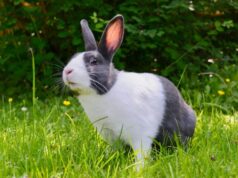Chicken during the experiment inspecting the two colored containers.Credit: Lund University / C. Schubert
The researchers have established that chickens — just like people — have colour constancy. For birds, this means that they, in different environments and under different lighting conditions, recognise the colour of, for instance, berries and can thereby distinguish those that are ripe from those that are not. Without colour constancy, they would not be able to rely on their colour vision — they would simply see the berries in different colours as the light changed. They would certainly also not be able to recognise their own kind of species.
The results were achieved by the researchers from training chickens. Initially, the chickens were kept in an environment with white light and had access to containers marked in three different colours: red, yellow and orange. Only by selecting the orange container would the birds receive food. The researchers then studied which container the chickens selected when the light in the room was switched to different shades of red. The results showed that the chickens continued to select the orange container.
“We studied many different lighting conditions to find out how big the changes in light could be without the chickens losing their colour constancy. This type of study has never been done before,” says Peter Olsson, biologist and one of the researchers of the world-leading Lund Vision Group at the Faculty of Science at Lund University.
By using a mathematical model, the researchers calculated how big the changes in light are inside the chickens’ eyes. The same model can be used on other animals and thereby allow researchers for the first time to compare the colour constancy of chickens and birds to the colour constancy ability in other animals.
“We can also compare the chickens’ colour constancy ability in the laboratory to the light changes they and other birds experience in nature, such as how the lighting conditions differ in the woods from in an open field. Our results show that they are able to maintain their colour constancy under greater changes in light in the laboratory than when experiencing those that occur in nature,” says Peter Olsson.
Find your dream job in the space industry. Check our Space Job Board »
The study was conducted by Peter Olsson together with his colleagues at Lund University and Bristol University. The article is published in the scientific journal Proceedings of the Royal Society B.
Source: Lund University
Journal: Proceedings of the Royal Society B: Biological Sciences
Research Reference:
- Peter Olsson, David Wilby, Almut Kelber. Quantitative studies of animal colour constancy: using the chicken as model. Proceedings of the Royal Society B: Biological Sciences, 2016; 283 (1830): 20160411 DOI: 10.1098/rspb.2016.0411











